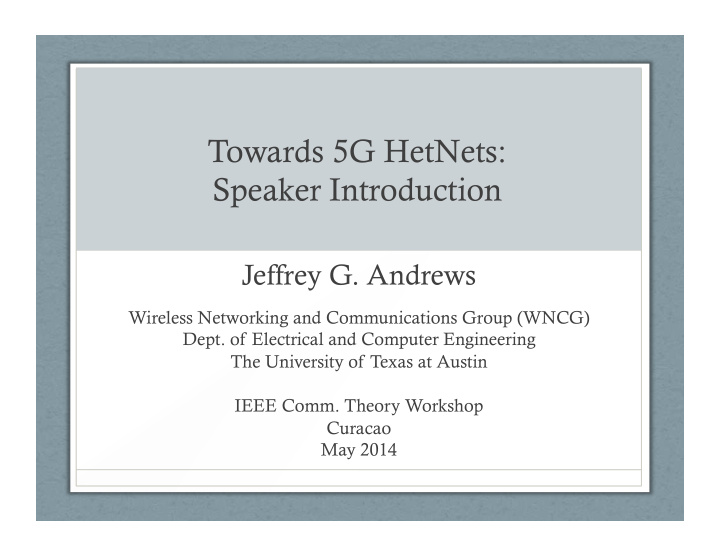



Towards 5G HetNets: Speaker Introduction Jeffrey G. Andrews Wireless Networking and Communications Group (WNCG) Dept. of Electrical and Computer Engineering The University of Texas at Austin IEEE Comm. Theory Workshop Curacao May 2014
5G and 10,000x the bps/Hz/km 2 : where will the gains come from? Bandwidth (20x more Hz) Only one place to go: mmWave mmWave + HetNets (Also LTE-U as stopgap) • very complementary • densifying mmWave cells yields huge gains (SNR plus cell splitting) • Can possibly do self- mmWave + massive MIMO backhauling! Some competition here • 5G • Improved SINR via mmWave with high gain Effective Density (50x antennas, interference goes More Loaded BSs/km 2 ): to zero? 4G Efficient HetNets, small cell and WiFi offloading, maybe D2D Spectral efficiency (10x more bps/Hz) HetNets + massive MIMO • HetNets may not be able to More dimensions (massive MIMO) utilize massive MIMO Interference suppression? Cost a key challenge here •
Your Speakers Ted Rappaport (NYU) • • The Messiah of millimeter Wave • “Millimeter Wave Cellular Communications: Channel Models, Capacity Limits, Challenges and Opportunities” • Two senior 3GPP contributors and inventors • That is, two of the guys who will actually design the 5G air interface • Preben Mogensen (NSN and Aalborg University) • “Looking Ahead to 5G: Building a Virtual Zero-Latency Gigabit Experience” • Erik Dahlman (Ericsson Research) • “Radio Access of the Future: Where to Go?” • Martin Haenggi (University of Notre Dame) • Top theoretician on stochastic geometry applied to wireless networks • “5G: The Quest for Cell-Less Cellular Networks” Gerhard Fettweis (Vodafone Chair, TU Dresden) • • 5G keynote last year’s CTW on “Tactile Internet”, this year will talk about a key challenge behind densification • “HetNet Wireless Fronthaul: The Challenge Missed”
Recommend
More recommend